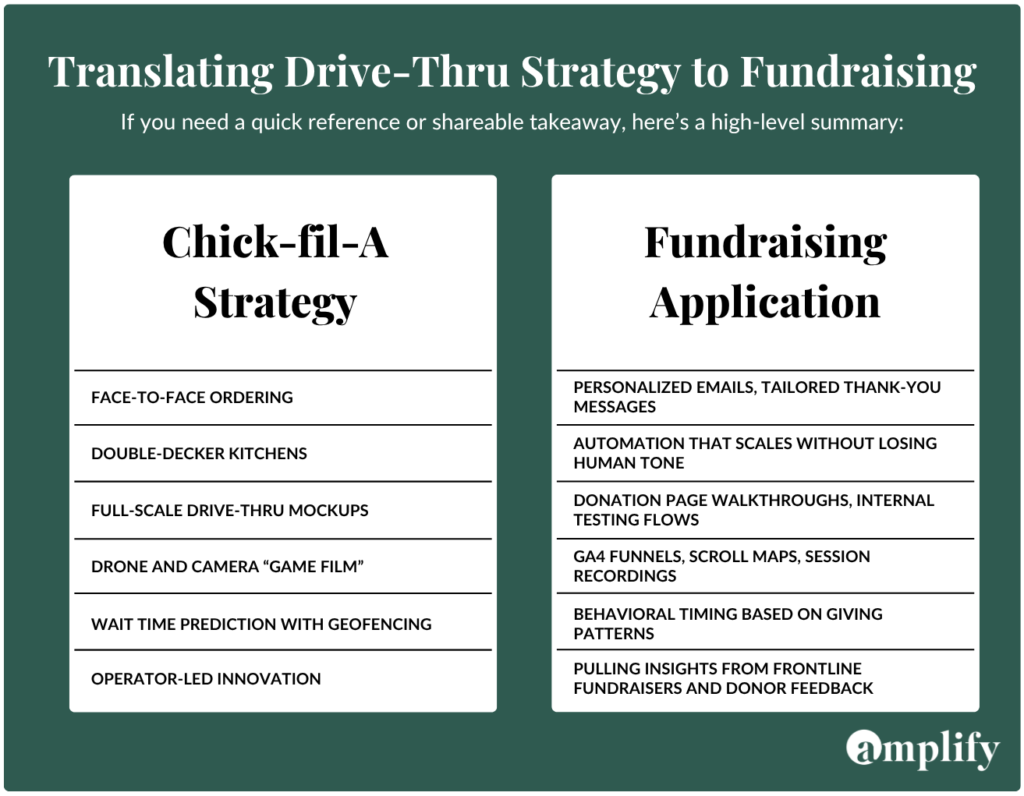Chick-fil-A, Fundraising, and the Fast Lane to Trust
By Brittany Thomas
If I’m choosing between a Chick-fil-A with 20 cars in the drive-thru or a Whataburger with five… Chick-fil-A wins every time.
It’s not just the food. It’s the experience. The person taking my order already knows how to move things fast. They ask my name, and they use it. The handoff is smooth. The window is clear. The “my pleasure” doesn’t feel fake. I leave feeling known and taken care of… in under five minutes.
Also, let’s be honest. I will drive completely out of my way for the Chick-fil-A peach milkshake. It’s seasonal, it’s magical, and it’s the reason I found myself in that 20-car drive-thru line this week.
Not every brand can pull that off. Some try. You can tell who’s studied the Chick-fil-A model. Take Raising Cane’s. They’ve got a team member outside, tablet in hand, and they ask for your name too. But then something breaks. No one ever uses it again. And when it’s time to grab your food, they tell you to pull up to the “last” window. Which, if you’re driving — and you are, because it’s a drive-thru — you won’t know which one is “last” until it’s already behind you.
Personalization + Process = Trust
Chick-fil-A doesn’t just smile and say your name. They’ve optimized every inch of that process. The double-lane merge. The point-of-sale handoff. The phrasing. The signage. All of it is designed to make you feel confident, respected, and known.
And it didn’t happen overnight.
Chick-fil-A has spent years refining its drive-thru system through mockup testing, drone footage analysis, and operator-led experimentation. At their Atlanta HQ, they’ve built full-scale drive-thru mockups with real cars to simulate flow and test improvements. Their Drive-Thru Innovation Team even analyzes drone footage like game film to uncover bottlenecks. One Rockford, Illinois location increased sales by 50 percent after changes based on these insights.
Other upgrades include:
Face-to-face ordering with tablets to improve speed and connection
Mobile Thru lanes for app users, with 85 percent of customers saying they’d use it again
Geofencing and wait time prediction, reducing waits by 1 to 2 minutes on average
Elevated double-decker kitchens, serving up to 700 cars per hour
Operator-led innovation, where franchisees test and share what works locally
All of it is intentional. None of it is accidental. And it works because the systems and the people are aligned.
So What Does This Have to Do With Fundraising?
A lot, actually.
Chick-fil-A’s success isn’t just about hospitality. It’s about operational clarity in service of the customer. That same mindset can be applied directly to digital fundraising, especially if we want to build trust, reduce friction, and create donor experiences that feel effortless and personal.
Here’s how the principles translate:
Real-World Testing
CFA runs full-scale simulations of its drive-thru. Nonprofits can do the same with their donation flows. Walk through your own giving experience. Watch someone else try it. See what feels confusing or clunky.
Try a side-by-side A/B test of landing pages — one focused on minimalism, another on narrative — and measure where donors drop off.
Journey Analytics
CFA uses drones and camera footage to study patterns. In fundraising, that’s your heatmaps, session recordings, and scroll-depth reports.
Look at the data. Are people skipping past your form? Clicking “give” but never submitting? That’s your version of a bottlenecked merge lane.
Humanized Interactions
Face-to-face ordering at CFA doesn’t just move things along. It creates connection. We can bring that same energy into digital donor touchpoints.
Use conditional personalization in email. Reference the donor’s last gift. Create dynamic confirmation pages with campaign-specific thank yous.
Infrastructure That Scales
CFA’s elevated kitchens increase capacity without losing consistency. Fundraising teams can do the same by combining automation with humanity.
Build automated journeys for new givers or recurring donors, but write them like you would to a friend.
Predictive Timing
CFA predicts drive-thru wait times based on behavior and location. You can do the same by timing outreach around when donors typically give — like month-end, paydays, or after impact updates.
Team-Informed Innovation
Some of CFA’s most effective process changes came from local operators. Your gift officers, digital managers, or community team likely have ideas sitting in their notes. Ask. Test. Build from the people closest to your donors.

This isn’t about copying Chick-fil-A. It’s about seeing what’s possible when systems and people are aligned toward a clear, generous outcome.
A Final Thought
At the end of the day, all of this — the testing, the systems, the tiny optimizations — is in service of something bigger.
We’re not just making things efficient.
We’re making it easier for people to say yes to generosity.
And that kind of clarity? It’s worth building for.
Your Turn
What’s the best customer service experience you’ve had — especially the ones where optimization and personalization actually worked together?
Shoot me an email (brittany@amplifyfr.com) of your favorite fast food drive-thru, online checkout, or donation experience in the comments. I’d love to hear what stood out.

Brittany Thomas
Head of Operations
Never Miss a Post!
We hope to post good and valuable content like this, without overwhelming your inbox once or twice per week. Want to be notified when a new post goes up? Complete the form below and we’ll make sure you get an email notifying you of new articles being published before anyone else gets notified.

